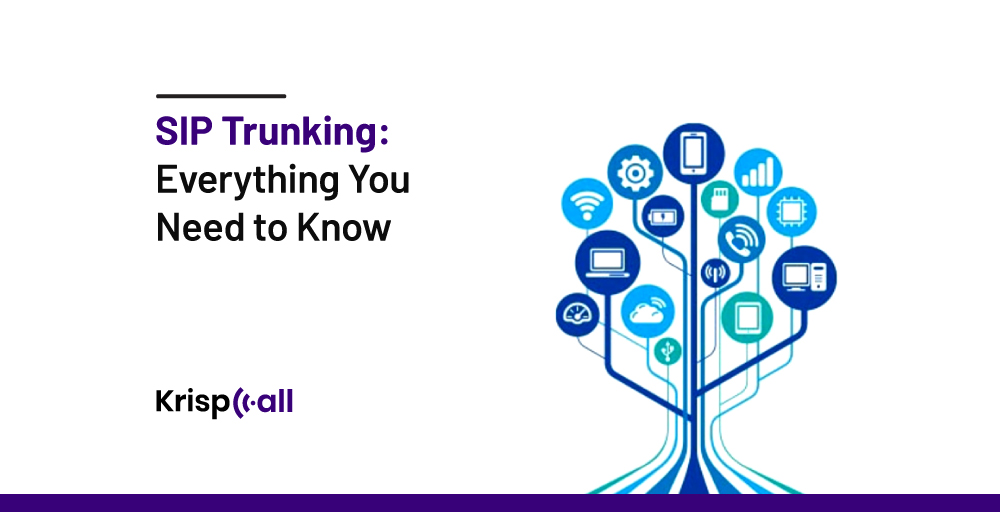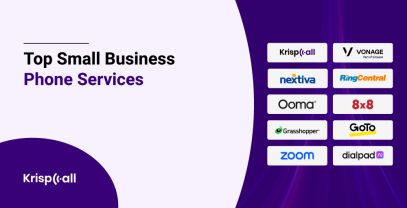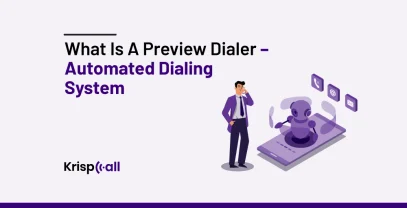Are you sick of confusing phone lines and sky-high bills?
Do you feel that traditional phone networks are as outdated as dial-up internet? 🙁
It is quite a struggle to pick the right technology that suits most of your business communication needs. VOIP solutions might help with calls 📞, but they lack many other features.
SIP Trunking is here to address that, it stands still as a proper solution to all your communication needs. From calls, and messages to Facetime and virtual conferences, you can have an excellent tool for collaboration.
Follow along, We bring you a complete guide on everything you need to know about SIP Trunking, including its working mechanism, configuration, and future trends.
🔑 Key Highlights
- SIP trunking is a way of making and receiving calls, messages, and videos digitally The term, “trunking” in SIP trunking means combining multiple virtual communication channels into one.
- You can get features like dynamic call routing, auto attendants, and subtle perks like flexible addressing using SIP trunking.
- SIP trunking is very beneficial to businesses as it helps them in Unifying Communication, assists call management, and gives them better flexibility.
- AI and 5G integration is going to make SIP trunking better and faster than it ever was up until now.
What is SIP Trunking?
SIP trunking is a digital method to make and receive phone calls 📞 and perform other communications over an internet connection.
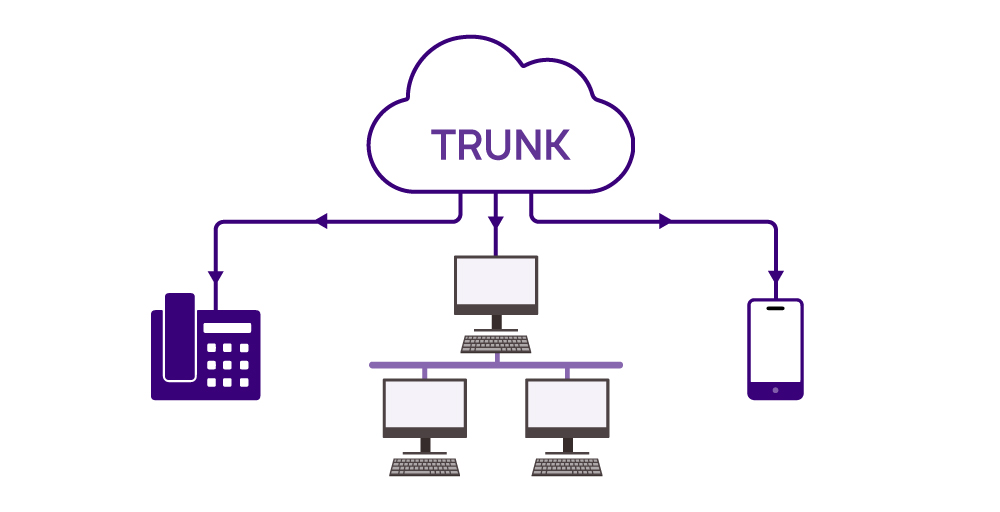
Basically, SIP stands for Session Initiation protocol, which is a standard set of rules allowing the creation/control of real-time ⌚ sessions between devices and applications for the exchange of voices, messages, multimedia, etc.
In other words, SIP trunking is a technology used to create a virtual communication link 🔗, i.e., basically a trunk, between a PBX system and the network’s service provider over the internet.
Cloud-based SIP trunking can work along with phones or other devices (connected to the internet) identifiable with IP addresses. Thus, based on the devices used, sessions can be made for calls and messages 💬 or even video chats.
What are the Benefits of SIP Trunking?
SIP trunking offers several benefits, whether it be for individuals or large enterprises. Some of them are:
- Cost Savings: SIP trunking eliminates the need for physical lines, reducing the costs of additional hardware requirements. With companies providing cloud-based SIP solutions, even the cost of PBX boxes is saved, plus you can have subscriptions and per-session cost models.
- Unified Communications: SIP supports various communication types, including voice, video, and messaging. As a result, employees can collaborate across a variety of modes of communication seamlessly, enabling unified communication.
- Call Management: SIP trunking provides all the session creation, modification, and termination privileges. It can be pretty helpful in routing and forwarding calls, setting up auto-attendants, etc.
- Flexibility: The virtual setup of SIP Trunking provides huge flexibility when it comes to adding communication devices or lines. A business can also easily add/remove various extended features based on its own requirements.
How does SIP Trunking Work?
Here are some steps that explain how SIP Trunking works.
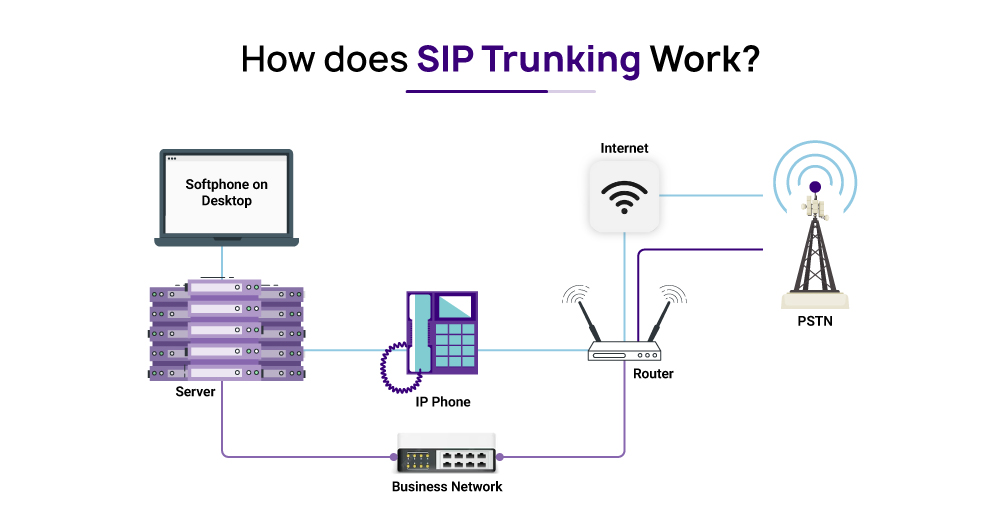
- Initiating session: Under the Session Initiation Protocol, and by setting various parameters, the initial step to establish a connection is started. It can be modified or ended as well.
- Connecting to PBX: With defined parameters, the first connection is made between the initiator and IP PBX via the internet.
- PBX connection to the trunk: The virtual PBX establishes a virtual connection with the larger SIP trunk, enabling the transfer of various forms of data.
- TRUNK connects other PBX (plus devices): The trunk, on the other side, is also connected to different devices and gadgets via PBX or internet services.
In this way, the Session is established between devices at two ends. This type of session can also be created within the same office premises, allowing the employees of a company to communicate through it.
How to Configure SIP Trunking in a Business?
SIP trunking is a big help for business talks. With benefits like an extra set of features and efficient large call management at a cheap cost, SIP trunking is a great tool for business communication.
To configure SIP trunking in your business smoothly, here’s a short step-wise guide for you.
1. Log into your PBX or IP devices
To start the SIP trunking setup for your business, initiate by accessing your PBX system and entering the system’s IP. Then, select the trunks section.
2. Create and add an SIP trunk
Establish a new SIP trunk to link your system externally. For identification purposes, assign a fitting name to the trunk, such as your business’s name, and specify the outbound caller ID as your business phone number.
3. Set the number of channels
Determine the maximum number of channels for the trunk and input SIP peer details. These details are used for the communications between the systems.
4. Register the Trunk
To complete the setup, register the trunk. If required, engage with VoIP providers for trunk registration.
5. Submit the changes
Once all details are in place, submit the changes and apply the configuration. With this process concluded, your trunk is ready, and the PBX is primed to send and receive calls.
What are SIP trunk Channels and Lines?
1. SIP Trunk Channel
Suppose a SIP session is established between two devices; that connection created is called a SIP Trunk Channel. The number of individual channels in an SIP trunk restricts the number of simultaneous executable calls because a single channel can execute only one concurrent call. SIP channels of a certain place are connected to the virtual PBX.
2. SIP Trunk Lines
SIP Trunk lines basically hold the same meaning as the SIP Trunk Channels. Since this term is similar to the previously prevalent physical telephone lines, it is used interchangeably with channels.
SIP Trunking Vs PRI: What is the difference?
Primary Rate Interface (PRI) is a relatively older technology that uses physical hardware and wired lines for connection, also going through PSTN (Public Switched Telephone Network) to connect with others.
While it is fundamentally different from SIP Trunking, some of the major differences between these technologies are listed in the table below:
| SIP Trunking | PRI |
|---|---|
| SIP Trunking can be a physical as well as a cloud solution. | PRI is a physical solution, requiring hardware installation. |
| Cloud solutions make them scalable as well as inexpensive. | Physical limitations confine the scalability of the technology, also making it relatively expensive. |
| Data is transferred in newer encrypted formats. | Utilises POTS technology for data transfers. |
| Cloud-based SIP connections can be accessed from anywhere through the Internet. | PRI connections are only limited within a certain location with physical setups. |
5 Best SIP Trunking Software Providers in 2024
With traditional phone systems slowly becoming a thing of the past, choosing the right SIP trunking software is very important for any modern business.
But with so many options available out there, finding the best can be a bit of a hassle.
Let’s dive in together and discover the best SIP Trunking providers that meet your business requirements.
| Provider | Features | Pricing |
|---|---|---|
| Vonage | Automatic Location-based Routing, Multi-Codec Support, Programmable SIP, TLS protection layer | Contact Sales Details |
| Nextiva | Comprehensive admin portal for management, Detailed call records and analytics, AI Integrations, Advanced fraud mitigation | Metered: $14.95 + $0.008 per minute, Unmetered: $24.95 and no minute charges |
| Twilo | Thousands of Integrations, Sales and Marketing Automation, Backup trunk providers, Programmable SMS, Mass notification | Contact Sales for Details |
| CloudTalk | Unified communication, Intelligent call routing, Callback, 3-way calling, Call redirect, Integrations with 35+ apps | $25/user/month (if paid annually), $30/user/month (if paid annually), $50/user/month (if paid annually), Contact sales for custom |
| 8×8 | Call waiting and holding, Video Conferencing, Call recording, Integrations, APIs | Starts at $20 per user per month Contact Sales for Details |
1. Vonage
Vonage is a pretty big name in the communication solution sector. With over 1600 telecommunication networks partnered in 96+ countries, it is an award-winning cloud calls/messaging service provider. It also provides programmable APIs to hundreds of thousands of developers.
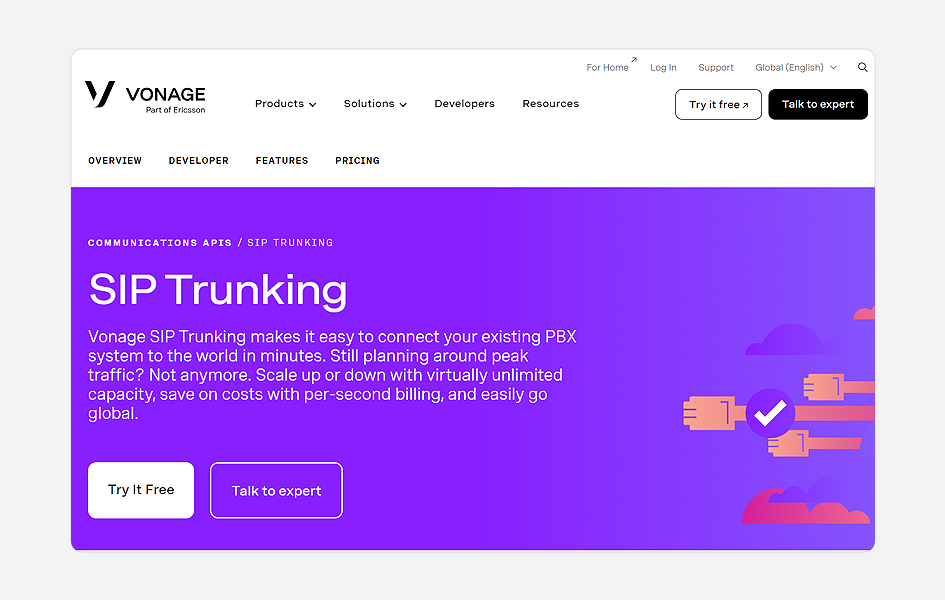
The trunking service that Vonage provides is relatively fast and flexible. Plus, it comes with convenient pay models, paying for only the trunks that you actually use, not requiring you to pre-provision any trunks. Using Vonage SIP Trunking, you can connect your existing PBX system to the world in minutes.
Features:
- Automatic Location-based Routing
- Multi-Codec Support
- Programmable SIP
- TLS protection layer
Pricing:
The SIP pricing of Vonage differs on several factors, like geographical location and additional features you are using. So contact the Vonage Sales team for exact pricing.
2. Nextiva
Established in 2006, Nextiva is a notable voice-over-internet-protocol (VoIP) company dedicated to furnishing businesses with comprehensive collaboration and communication solutions.
Nextiva offers a reliable SIP solution for their customers that requires no prior coding experience. With 8 cloud servers for the SIP operation, the company provides very reliable and scalable trunks for even large-scale businesses.
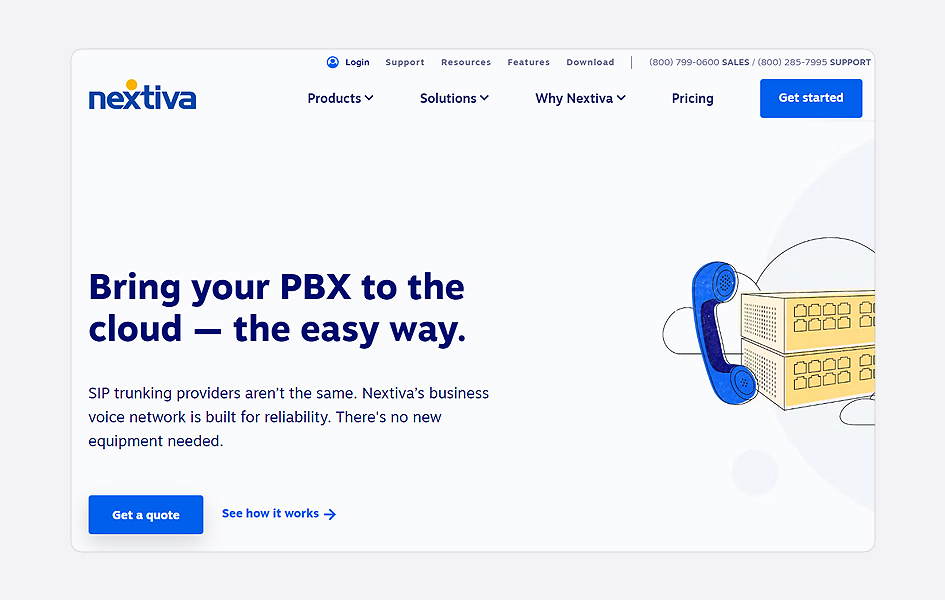
Also, setting up Nextiva SIP is completed in four easy steps. It includes getting a personalized quote, checking compatibility, porting numbers, and establishing PBX connectivity.
Other than SIP trunking, Nextiva’s solutions include tools for sales, VIP phone service, email marketing automation, contact centers, and video conferencing.
These tools are designed to make work more efficient, and they use Artificial Intelligence (AI) to enhance the overall customer experience.
Features:
- Comprehensive admin portal for management
- Detailed call records and analytics
- AI Integrations
- Advanced fraud mitigation
Pricing:
- Metered: $14.95 + $0.008 per minute
- Unmetered: $24.95 and no minute charges.
3. Twilio
Twilio is a large American-based telecommunication company founded in 2008. It provides programmable communication tools for developers to enhance communication functionalities. Over 290,00 brands use services provided by Twilio.
Twilio’s Programmable Voice SIP Interface allows other businesses to utilize their current SIP communications setup to start SIP sessions with the Twilio Cloud. Its SIP solution is easily deployable plus highly scalable.
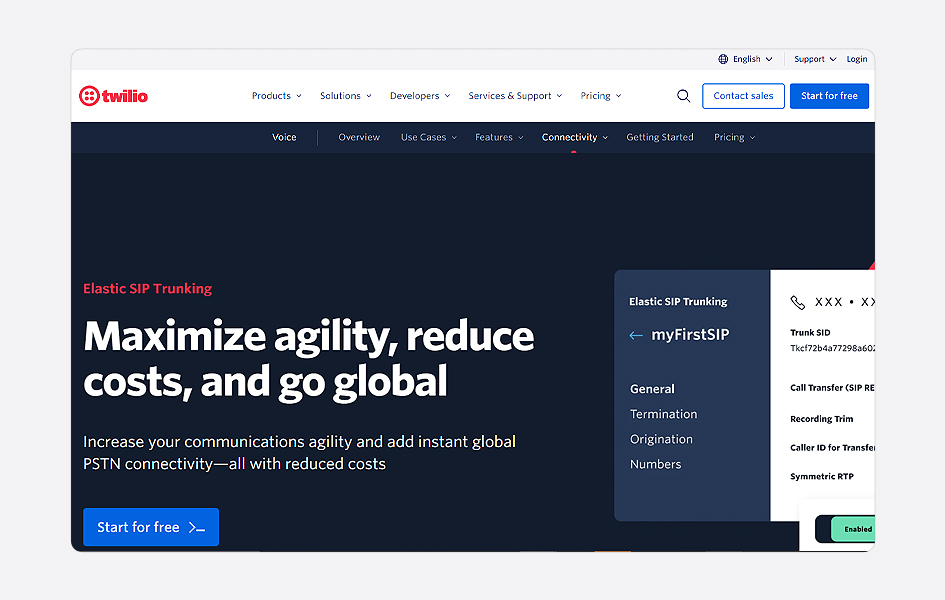
Their self-service tools let you deploy globally in minutes without relying on providers. Moreover, Twilio Elastic SIP Trunking is a pay-as-you-go model; no contracts and no channel/port fees are needed.
Similarly, in 2021, TMCnet honored Twilio Elastic SIP Trunking as Product of the Year for innovation and excellence. The company was also ranked among the top SIP trunking providers in a report based on customer satisfaction surveys taken in 2020.
Features:
- Thousands of Integrations
- Sales and Marketing Automation
- Backup trunk providers
- Programmable SMS
- Mass notification
Pricing:
Pricing depends on various factors, so better contact Twilio’s Sales Team for an in-depth pricing structure.
4. CloudTalk
Cloudtalk stands out as a well-known call center software renowned for its expertise in data analytics, automation, scalability, and seamless CRM integration. It extends its services across more than 12 countries, making it a versatile solution for diverse business needs.
One of the notable strengths of CloudTalk SIP trunking solution lies in its extensive array of integration options, accommodating the varied communication demands of any business.
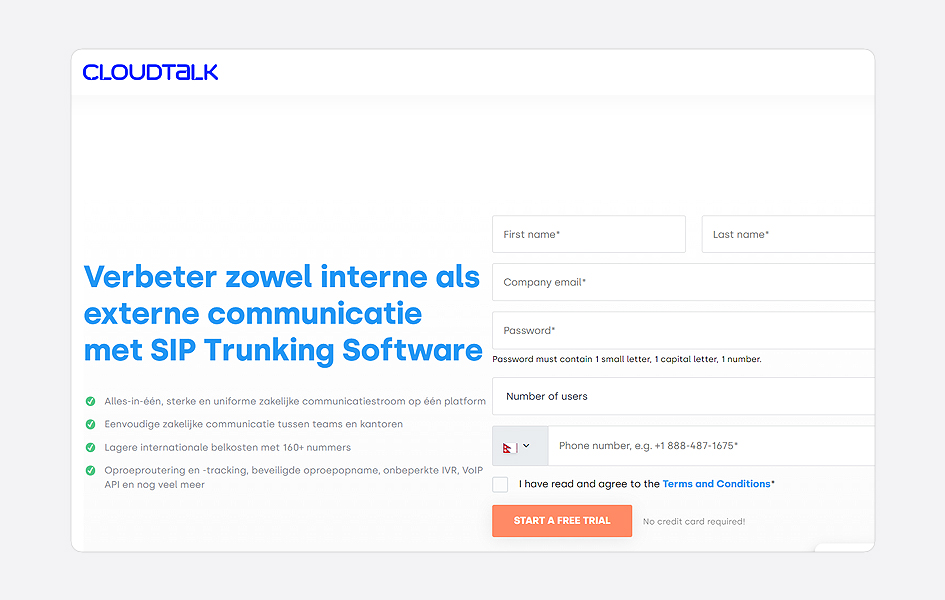
Additionally, it provides users with the opportunity to explore its capabilities through a free demo before committing to any purchases.
Moreover, CloudTalk‘s SIP trunking provides companies with a unified communication platform. With unified communication, you can send video conferencing, text messages, and collaboration tools, all from one app.
Features:
- Unified communication
- Intelligent call routing
- Callback
- 3-way calling
- Call redirect
- Integrations with 35+ apps
Pricing:
- Starter: $25/user per month (billed annually)
- Essential: $30/user per month (billed annually)
- Expert: $50/user per month (billed annually)
- Custom: Contact for tailor-made offers
5. 8×8
Lastly, 8×8 is now among the top five SIP call providers. It was founded in 1987 and is well-known for its cloud and call center software, providing its services in over 55 countries.
This US-based telecom service provider makes an all-around phone system that works on the cloud to help businesses, big or small, with their communication needs.

The SIP solution of 8×8 has many modern features, such as strong services for contact centers and several integrations. It also comes in very handy with CRM integrations and different business programs.
Additionally, most of the 8×8 SIP service plans include unlimited calling and 99.99% uptime guaranteed.
But, we should remember that the high cost and difficulty of using 8×8 could be a problem for small businesses or those who don’t know much about technology.
Features:
- Call waiting and holding
- Video Conferencing
- Call recording
- Integrations
- APIs
Pricing:
Starts at $20 per user per month
Other pricing structures may completely vary, so contact the 8×8 sales team for a better understanding.
What are the future trends of SIP Trunking?
As the world is marching towards a technological utopia, the future holds even better plans for SIP Trunking. Briefs on some of such future trends in the tech are:
- AI Integration: With advanced models, AI will not only help to get better analytics but also to improve overall customer experiences. From automated call routing to the use of AI assistants, the border between reality and sci-fi will blur out.
- 5G integration: The use of 5G in SIP Trunking will ensure better and faster connectivity between the communicating devices. It will also reduce latency and help businesses use more sophisticated cloud features.
- Advanced Encryption: An increase in global computing power will affect the current encryption techniques more in the future. Thus, to protect the SIP trunks from attackers, advanced encryption methods will be utilized.
Final Words
SIP Trunking is a technology that enables businesses to execute calls, share messages and media, etc., with efficient prices and extended features. Features like dynamic call routing, video conferencing, auto attendants, and subtle perks like flexible addressing make it a preferable choice for many.
And talking about preferable choices on SIP service providers, there isn’t a holy grail solution to immediately go with. The right provider really depends upon the best needs of your business. Analyzing the information mentioned above about the top trunking software, plus doing a little bit of research on trunking services, will give you a better idea.
FAQs
Is SIP Trunk VoIP?
Yes, SIP trunking is a part of Voice over Internet Protocol (VoIP) technology. VoIP is a big term that means talking on the phone using the internet. SIP (Signalling Protocol) helps to start, keep going, and end real-time sessions when you do things like voice calls or message exchanges over video.
Is SIP trunking secure?
Though SIP Trunking is relatively more secure than other older technologies, it is not entirely secure, especially considering the connections are established over the Internet and in some remote servers. However, you can apply various encryption methods offered by the service providers to make your trunking secure.

